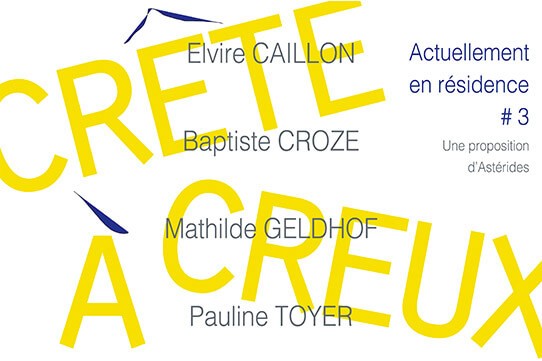Actuellement en résidence #3 – Crête à creux
Collective show with Elvire Caillon, Baptiste Croze, Mathilde Geldhof and Pauline Toyer
November 9 - November 26, 2016, public opening on November 9 from 6:30PM
Espace HLM / Hors les Murs, 20 rue Saint Antoine, 13002 Marseille
Crête à creux [Crest and Trough]
Crest and Trough, a multiplicity encompassed by an inquisitive title, unfolds in space, delighting in the way its entities respond to one another through interactions of materials, suspensions, and figures, while fully engaging with the spatial body. Photographs, inverted castings, paintings, sculptures, and formless materials question and echo one another, sometimes ignoring each other altogether. The works unintentionally form a system of response and non-response, creating variations of crests and troughs.
All of the pieces presented by Elvire Caillon, Baptiste Croze, Mathilde Geldhof, and Pauline Toyer stem from their residency at the Astérides studios. This shared spatio-temporal framework, along with the context of the group exhibition, fosters connections, circulations, and bridges between forms and concepts that initially had no apparent reason to meet, let alone engage in dialogue. Crest and Trough offers a journey through these uncovered links and contaminations.
It is now up to us to observe these nods and convergences, while also appreciating the original autonomy of each work. Some are born from wanderings through the city of Marseille: Mathilde Geldhof, for instance, offers everyday panoramas that make visible the specificities of the territory and in which scenes and narratives take shape.
Elvire Caillon focuses on forms, colors, and postures—on the ways individuals appropriate their environments. She captures atmospheres and plays with irony in paintings of various sizes, filled with bold, shimmering primary colors.
Irony also cloaks the cast-off shells and suspended saws of Baptiste Croze, who enjoys collecting and reworking objects, placing them in novel situations that upend our innate representations.
Pauline Toyer questions environments through their materials—often organic and shifting—which she reclaims to compose phenomena that become disrupted. The nearby sea, for example, becomes an opportunity to explore how salt evolves over time and in contact with other materials. These elements contaminate each other in more or less controlled ways—just like the subjects and concepts of the works gathered here.

